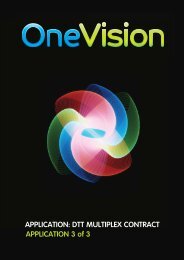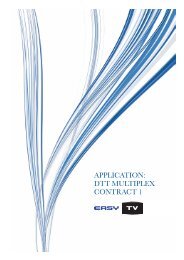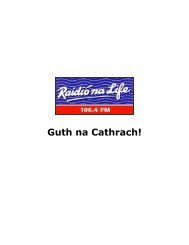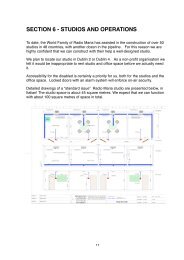Digital Radio for Ireland: Competing Options, Public Expectations - BCI
Digital Radio for Ireland: Competing Options, Public Expectations - BCI
Digital Radio for Ireland: Competing Options, Public Expectations - BCI
You also want an ePaper? Increase the reach of your titles
YUMPU automatically turns print PDFs into web optimized ePapers that Google loves.
<br />
Online <strong>Digital</strong> <strong>Radio</strong> <br />
<br />
• Of 91 radio services in <strong>Ireland</strong> audited, 81% have a website (4 of the 22 community, special <br />
interest and institutional services did not). Only 9 of the 22 temporary services had a website. <br />
The vast majority of all radio websites are of the brochure type and offered some element of <br />
audio content on the site but are not seen as Web 2.0 in their content or design. <br />
• In general Irish radio websites are relatively basic in design and functionality. The overall <br />
theme is a brochure site, a print centric website with add‐on elements such as audio or <br />
interactivity. Only about one third of the websites were defined as ‘websites with a dynamic <br />
content’. The re‐launched RTÉ 2FM website was one example, during the period of the <br />
website audit, of a significant shift by a radio station to a more dynamic Web 2.0 approach. <br />
• While the vast majority of radio stations with websites provide some <strong>for</strong>m of audio content, <br />
its scale and depth varies greatly. 86% offer live streaming. While at a national level, the <br />
websites of RTÉ’s 4 FM stations, Today FM and Newstalk 106 all offer podcasts; roughly half of <br />
all local stations audited provide podcasts at some level. The majority of community stations <br />
(over 60%) do not provide podcasts. <br />
• A survey of over 100 European public radio services online, showed that the vast majority <br />
provided some <strong>for</strong>m of audio and all public radio services in the survey offered podcasts and <br />
live streaming. <br />
• Live Streaming is the most important <strong>for</strong>m of making audio content available online followed <br />
by podcasting and ‘listen again’ facilities. <br />
What <strong>Radio</strong> Listeners Say <br />
• In an international context, radio listening in <strong>Ireland</strong> ranks highly. Looking at 2007 data in a <br />
comparative context, <strong>Ireland</strong> had a daily reach of 84% and an average of 29.3 hours listened <br />
per week. (The current daily reach according to JNLR is 86%) <br />
• UK research shows that that internet radio and podcasting is helping radio develop a life with <br />
younger audiences, under 30 years and it is encouraging people to experiment and try new <br />
radio shows. <br />
• In <strong>Ireland</strong>, most receivers available in Irish households are of a fixed radio (88%) or car radio <br />
(87%) type yet there is evidence of a growing diversity of plat<strong>for</strong>ms <strong>for</strong> radio listening with <br />
over 40% of the population reporting they can receive radio via TV, on a PC, on a mobile <br />
phone or MP3 player. <br />
• Current listenership via devices other than fixed or car radios is low: 15,000 <strong>for</strong> radio on a <br />
mobile phone, 8,000 on an MP3 player, 7,000 on a PC/internet, 7,000 on a TV set, and 4,000 <br />
on any other digital <strong>for</strong>mat. <br />
• Focus group members reported a diversity of radio listening habits using different plat<strong>for</strong>ms. <br />
About one third had knowledge of or owned a DAB receiver. While listeners enjoyed the <br />
7






